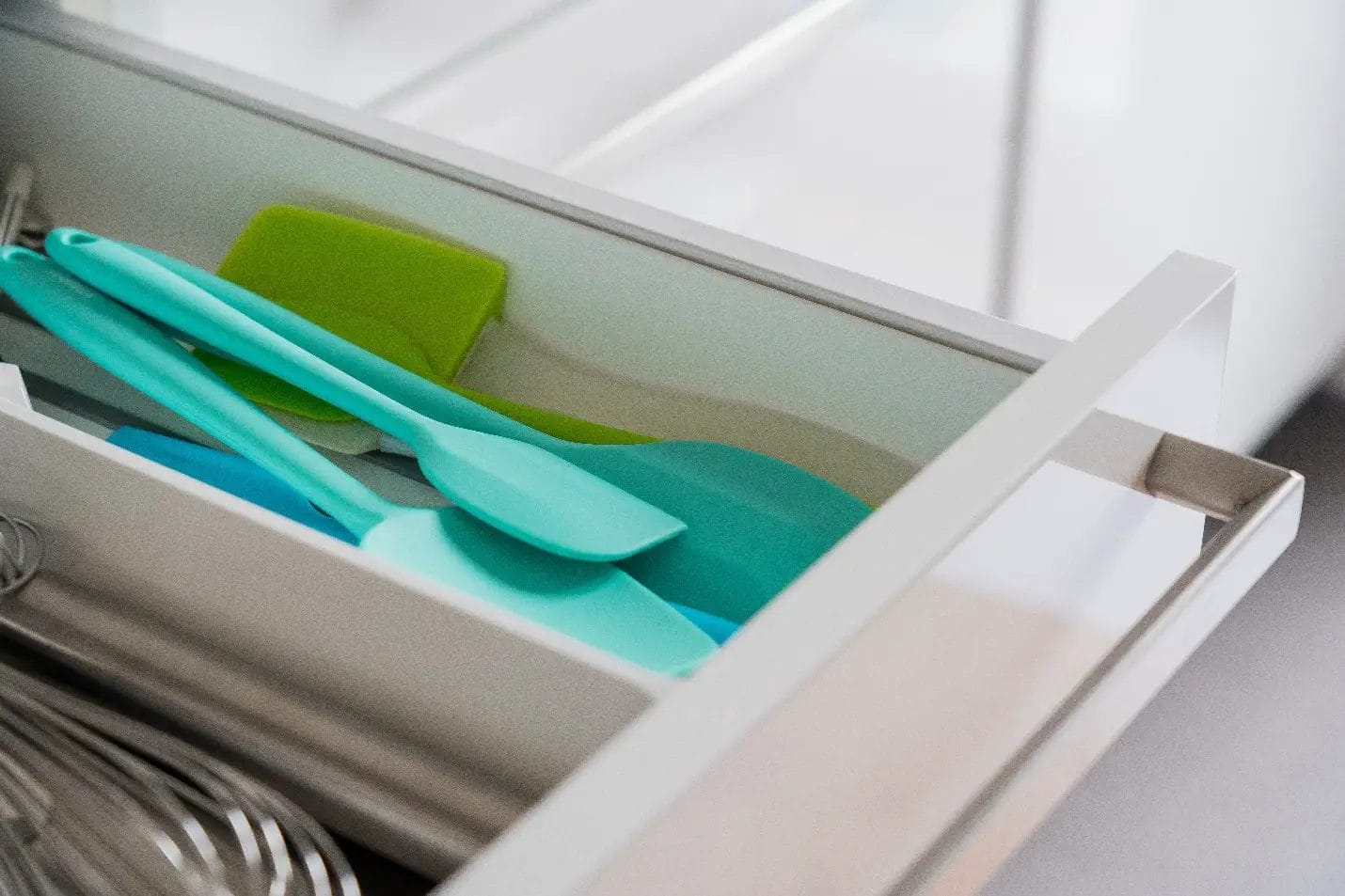Every homeowner wants to ensure the safety of the cooking utensils they use to prepare meals for themselves and their loved ones. With so many kitchenware options available to choose from, it all comes down to which cooking utensil is the best.
Traditionally, every household has been equipped with various metallic and wooden cooking utensils. Recently, a massive shift towards silicone spoons, whiskers, bakeware, and spatulas has been seen almost everywhere.
Easily available at all kitchenware shops worldwide, silicone cooking utensils have taken the culinary world by storm. One can see vibrant silicone cooking utensils dominating the kitchens at cooking shows, cooking competitions, and food-related media.
Continue reading this article to understand if silicone cooking utensils are the best available kitchenware option or not.
What Are Silicone Cooking Utensils?
Silicone is an inert form of synthetic rubber. The chemical composition of silicone includes silicone, oxygen, and sometimes carbons atoms bonded together to form a strong and unreactive compound.
Traditionally silicone has been used in:
- The making of non-stick sprays;
- The making of parchment paper that prevents food from sticking to a pot or pan’s base;
- An adhesive used in building construction;
- The making of medical implants, IV tubes, and mensural cups;
- A sealant grease that is used to coat bathroom and kitchen faucets to prevent water leakage and cracking.
Over the recent decades, the silicone industry has seen massive growth after gaining commercial popularity in the kitchenware business. Silicone cooking utensils are loved for their vibrant color options and are mostly found as spoons, whisks, spatulas, measuring cups, bakeware, cooking molds, and basting brushes.
Are Silicone Cooking Utensils Better?
Silicone cooking utensils have many qualities that make them a consumer favorite. These qualities make silicone kitchenware better than wood, plastic, or metal utensils in many ways.
The advantageous characteristics of silicone cooking utensils are elaborated below.
Silicone Cooking Utensils are User-friendly
Silicone kitchenware has rubber-like flexible bodies. This flexibility makes it easier for the user to stir and work around any pot shape. Moreover, easily-bendable silicone spatulas can scrape food contents perfectly from any type or shape of food container. For example, a silicone spatula can be used to perfectly scrape off every last drop of cake batter from a mixer bowl. As a result, food wastage is reduced, and cleaning gets convenient.
This user-friendly quality makes silicone cooking utensils especially great for novice cooks.
Silicone Cooking Utensils Do Not Damage Other Cookware
Using metal spoons and spatulas can damage the non-stick layer of a frying pan or a cooking pot. As a result, the pan or pot no longer has non-stick bases, and food can stick to its surface during cooking. The stuck-on food makes cleaning inconvenient and leads to food wastage.
Silicone cooking utensils have soft rubber-like bodies that easily scrape off food contents without damaging the cookware’s non-stick surface. Moreover, the homeowner does not have to reinvest in new non-stick pots and pans frequently.
Silicone Cooking Utensils Have Great Temperature Resistance
Silicone kitchenware is made of silica sand and oxygen atoms. This strong chemical construction makes the silicone material temperature resistant. They remain undamaged up to 220 Celsius or 428 degrees Fahrenheit and do not break when kept in the freezer. Hence, stirring a silicone spoon in hot foods does not allow any silicone to melt and leach into the food contents. As a result, silicone kitchenware does not lose its color and remains odor-free. This characteristic makes cleaning and washing convenient and less costly.
Moreover, unlike metal or wood utensils that get permanently damaged from excess heat, silicone cooking utensils remain unaffected over prolonged usage. Furthermore, the rubber-like chemical compositions make silicone kitchenware great heat insulators. As a result, silicone kitchenware does not get overheated during heat exposure and remains easy to handle.
The insulating quality of silicone has helped design lightweight kitchen gloves for handling extremely hot bakeware.
Silicone Cooking Utensils Are Nontoxic to Human Health
Silicone kitchenware is made from food-grade silicone, which is safe, non-corrosive, and nontoxic. These silicone utensils’ impermeable and inert nature makes them unreactive to harsh chemicals and extreme temperatures. Hence, no silicone contents leach into the food being cooked. Many experiments and studies have concluded that, unlike plastic kitchenware, heating food-grade silicone does not release any hazardous fumes.
Moreover, unlike wooden spoons that are moisture absorbent and allow fungal growth, silicone cooking utensils do not sustain any microbial organisms.
Furthermore, the high-temperature resistance ensures no silicone melts and mixes with the food content, making them safe for cooking and oven use. This quality allows the silicone kitchen utensils to retain their shape and quality for extended periods of use.
Silicone Cooking Utensils Do Not Break Easily
Ceramic bakeware and cooking molds are safe, nontoxic, and have high-temperature resistance. However, they can easily crack from a single drop. A chipped corner would make handling difficult and dangerous while increasing the chances of food wastage.
Silicone cooking utensils do not break as quickly and are as safe and heat resistant as ceramic. Hence, using silicone molds, dishes and bakeware is the better choice.
Moreover, prolonged usage of silicone molds does not make them hard, brittle, crumbly, or dry.
Silicone Cooking Utensils Are Reusable
Conventional cupcake liners are made from paper. Although paper cupcake liners are recyclable and biodegradable, they cannot be reused.
Silicone cupcake or baking molds can be reused multiple times without getting damaged. This quality makes investing in silicone bakeware cost-effective.
Silicone Cooking Utensils Are Lightweight
Silicone cooking utensils are extremely lightweight compared to metallic utensils. The lightweight nature of silicone kitchenware allows older and physically challenged individuals who otherwise cannot stir a heavy metal spoon to practice cooking comfortably. Moreover, little children can also develop an interest in the kitchen and enjoy experimenting with cooking.
Furthermore, lightweight silicone kitchenware can easily be transported and stored anywhere.
Silicone Cooking Utensils Are FDA Approved
The late 1890s first introduced silicone cooking utensils; however, their official food-grade approval took much longer. In 1979, after extensive research and experiments, silicone cooking utensils were permitted to go commercial. The American Food and Drug Administration (FDA) concluded that the chemical composition of silicon and oxygen atoms make silicone a safe food-grade material.
Moreover, silicone cooking utensils contain no BPA (Bisphenol A), lead, or latex. These compounds can interfere with the human body and inhibit regular bodily functions.
Silicone Cooking Utensils Are Eco-friendly
The manufacturing process of silicone cooking utensils is environmentally safe, unlike plastic, metal, and wood kitchenware that compromise the Earth’s environment. For instance, manufacturing plastic utensils requires crude oil mining, which negatively affects the landscapes and pollutes the environment. Moreover, wooden cookware involves chopping trees, which leads to less oxygen production.
On the other hand, silicone cooking utensils are made from silica, a sand derivative. No mining or chopping of trees needs to be carried out, and hence environment is not compromised.
Although silicone utensils are non-biodegradable, they can be used for many years and are recyclable. Hence, preferring silicone kitchenware can avoid environmental pollution.
Furthermore, silicone kitchenware does not break into smaller plastic compounds that could potentially harm the oceans and aquatic life.
Other Kitchenware Options
Stainless Steel Cooking Utensils
Stainless steel kitchenware mostly contains nickel, chromium, and steel. Stainless steel pans and pots avoid food sticking to the base and are convenient to clean and maintain. For more evenly heating, aluminum traces are added to the stainless-steel kitchenware.
Despite the high durability and shiny appearance, stainless steel kitchenware is hazardous to human health. The heavy metal constituents can leach into the food when exposed to prolonged heating. Nickel-contaminated food contents have been found to trigger severe allergies in some people. Moreover, cooking acidic foods can cause the stainless-steel surfaces to corrode. As a result, their non-stick qualities are reduced, and the chances of food contamination increase.
However, stainless-steel kitchenware’s easy availability and recyclable nature make them a popular consumer good.
Wooden Cooking Utensils
Wood kitchenware is a poor heat insulator and is easy to handle. Wood is a renewable and biodegradable compound that does not add to the global environmental pollution crisis. This quality makes wood a great alternative to plastic kitchenware and cutlery. Moreover, the global abundance of wood makes wooden kitchenware cheap and easily available.
However, wooden cooking utensils contribute to global deforestation. As a result, atmospheric oxygen levels are reduced, and carbon dioxide levels increase. Moreover, the porous nature of wood allows it to absorb and retain water from cooking and washing. Wet wooden utensils tend to harbor microbial growth, contaminating the food contents.
When placed in a fridge or cabinet, chances of cross-contamination to other utensils increase. The spread of bacterial growth could contaminate the entire drawer or refrigerator. As a result, the homeowner might have to invest in all-new utensils or throw out all refrigerated food items.
Furthermore, the absorption tendencies allow the wood to retain odors and colors from cooking. Hence, wooden kitchenware needs to be discarded after some time.
Ceramic Cooking Utensils
Ceramic kitchenware is made from naturally occurring compounds such as quartz sand and clay. The compound mixture is poured into molds and baked in high-temperature kilns.
Ceramic cooking utensils are cheaper than stainless steel options and are eco-friendly. Ceramic cooking pans and pots have high heat resistance, are lightweight, easy to clean, and unreactive to acidic foods. Unlike most stainless-steel kitchenware, ceramic-coated utensils contain no lead, cadmium, BPAs and do not release toxic fumes after overheating. However, silicone cooking utensils have higher heat resistance and are more inert and lighter.
Moreover, ceramic cooking utensils can instantly break from a single drop, leading to food wastage. Furthermore, ceramic kitchenware loses its non-stick abilities faster than Teflon kitchenware. The surface of ceramic pots and pans can easily get scratched from metal spatulas, and the chipped-off ceramic traces can contaminate the food.
Glass Cooking Utensils
Glass is often used to make pans, pots, storage containers, and baking dishes. Glass cooking utensils are microwave safe, nontoxic, eco-friendly, and can last a long time. This quality makes glass perfect for storing and heating foods, compared to plastic containers. Moreover, glass utensils are convenient to clean and are dishwasher friendly.
However, unlike silicone utensils, glass kitchenware is not as temperature resistant and can crack when exposed to extreme temperatures. Moreover, glass containers and dishes can instantly break after a single drop.
What Are the Disadvantages of Using Silicone Kitchen Utensils?
Silicone kitchen utensils are amazing heat insulators, offering great heat resistance and easy handleability. They are lightweight and highly flexible, making cooking easy for everyone. Despite the many benefits that make silicone kitchenware better than other market options, there still are some disadvantages of using silicone utensils.
Some of the disadvantages of using silicone kitchen utensils are as follows:
- It is hard to find 100% pure silicone kitchenware. Most commercial silicone utensils contain high amounts of plastic fillers that may contain BPA and lead. These impurities make silicone kitchenware toxic, less heat resistant, and less durable;
- The rising popularity of silicone kitchenware has resulted in many impure silicone varieties dominating the mainstream market;
- Silicone utensils cannot be as easily recycled as paper or wood. Rather, special recycling centers are needed to melt and remold the silicone into other shapes and products.
Final Thoughts
According to recent statistics, the global silicone market is expected to grow up to USD 23.4 billion in the coming decade. A big segment of this massive industry deals in kitchenware and cooking utensils.
Silicone cooking utensils are more durable, stronger, malleable, and heat resistant than wood, stainless steel, ceramic, or glass utensils. They are lighter in weight and are unreactive and nontoxic. Hence, with the availability of silicone recycling centers, 100% pure silicone kitchenware is far better than its other market competitors.


